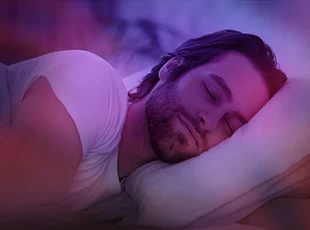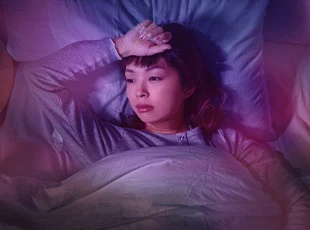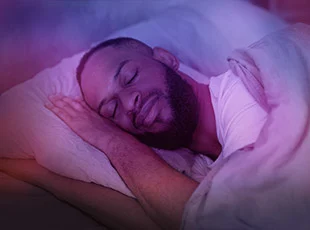There are several different states and stages of sleep (known as your “sleep architecture”,) and some leave you feeling more rested than others. Your sleep architecture follows a predictable pattern of REM (Rapid Eye Movement) and NREM (Non-Rapid Eye Movement) sleep
1. Each of these states alternates approximately every 90 minutes. Read on to learn more about the different stages of sleep and how you can wake up feeling refreshed and well-rested.
TYPES OF SLEEP
Non-REM sleep
Stage 1: Light sleep, easily awakened, muscles relax with occasional twitches, eye movements are slow.
Stage 2: Eye movements stop, slower brain waves with occasional bursts of rapid brain waves.
Stage 3: Occurs mostly in the first half of the night. Deep sleep, difficult to awaken, large, slow brain waves, heart and respiratory rates are slow, and muscles are relaxed.
The third stage of non-REM sleep is the deepest sleep phase—it’s the one that makes you feel well-rested and energetic the next day. This stage of sleep is also when the body repairs and regrows tissues, builds bone and muscle, and strengthens the immune system.
REM sleep
Usually first occurs about 90 minutes after you fall asleep, and longer, deeper periods occur during the second half of the night. It cycles along with the non-REM stages throughout the night.
Eyes move rapidly behind closed eyelids.
Breathing, heart rate and blood pressure are irregular.
Dreaming occurs.
Arm and leg muscles are temporarily paralyzed.
REM sleep is believed to be beneficial for learning, memory and mood.
Benefits of REM sleep
REM sleep accounts for approximately 20 to 25 percent of an adult’s sleep cycle, and over 50 percent of an infant’s. Most dreams occur during REM sleep, and according to the National Sleep Foundation
2, a lack of REM sleep may have adverse implications for physical and emotional health. For instance, REM sleep is believed to be beneficial for learning, memory, and mood.
Common sleep problems
Although our need for sleep does not change as we grow older, sleep can become more challenging in later adulthood. For women, the onset of menopause brings hormonal changes that can disrupt sleep. Many older adults find it difficult to stay asleep at night, or they may have a pattern of waking up very early in the morning. Certain adults may experience insomnia, a serious sleep disorder in which you have trouble falling and/or staying asleep. The condition can be short or long-term and may also fluctuate over time. Life experiences that can be stressful, such as job loss, death of a family member or normal life transitions and phases, can upset sleep and make restful nights elusive. Short periods of difficulty falling or staying asleep are somewhat common, however, and do not necessarily occur hand-in-hand with a major medical condition. If you think you’re experiencing insomnia, seek guidance from your healthcare professional.
How to get restful sleep
A healthy adult requires 7-9 hours of sleep per night, and sleeping less than this can reduce the number of REM sleep cycles.
If you suffer from occasional sleeplessness, an over-the-counter sleep medication can help such as ZzzQuil.
If you’re looking for a drug free approach, the sleep experts at Vicks also designed ZzzQuil PURE Zzzs Melatonin as a sleep supplement that will help you fall asleep naturally* so you can take on your tomorrow. It’s formulated with an optimal level of melatonin for no next-day grogginess,* which has been shown to help support your natural sleep cycle, and a proprietary blend of botanicals, including chamomile and lavender.
In addition to these sleep suggestions, it’s beneficial to make sure your bedroom gives you the best opportunity for a good night’s sleep. Check out our article on how to create a relaxing bedtime routine here.
Hope these help, and sweet dreams!
Read more about tips to fall asleep faster and melatonin.
*These statements have not been evaluated by the U.S. Food and Drug Administration. This product is not intended to diagnose, treat, cure or prevent any disease.






